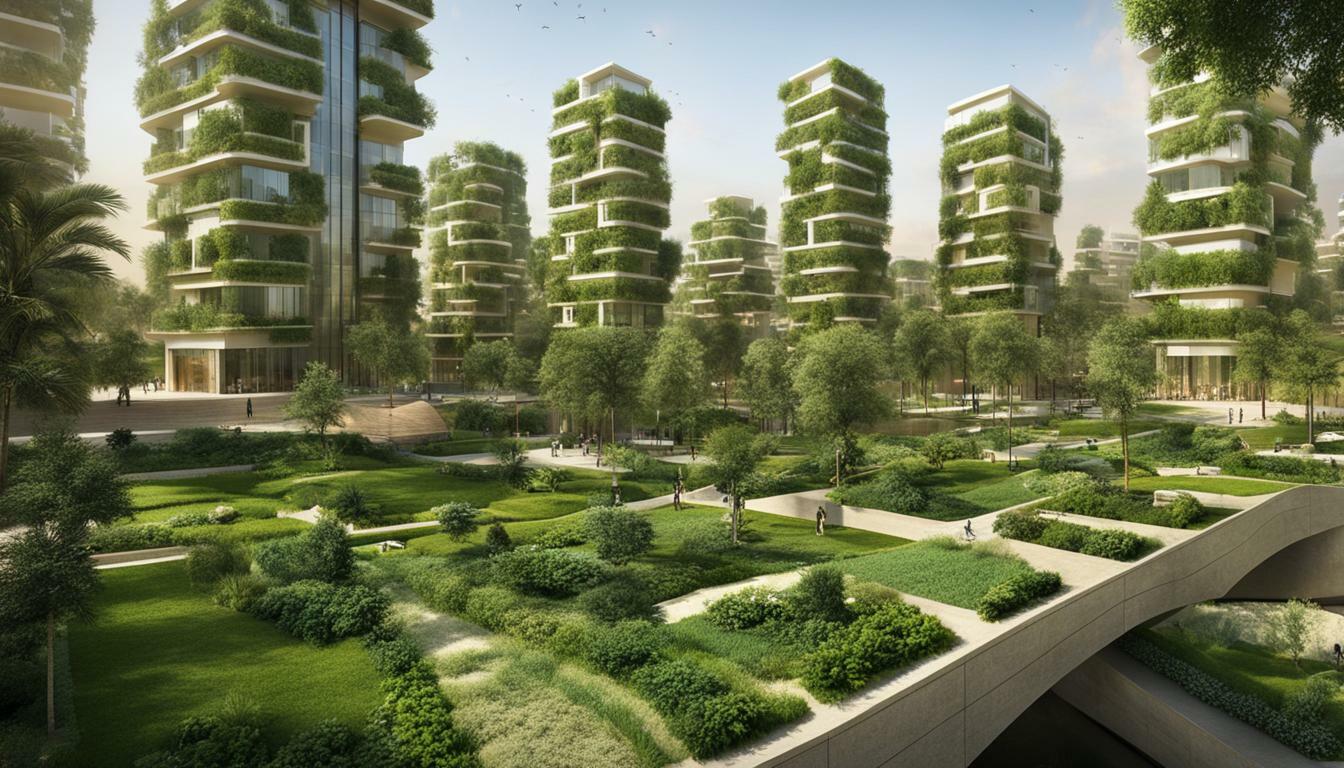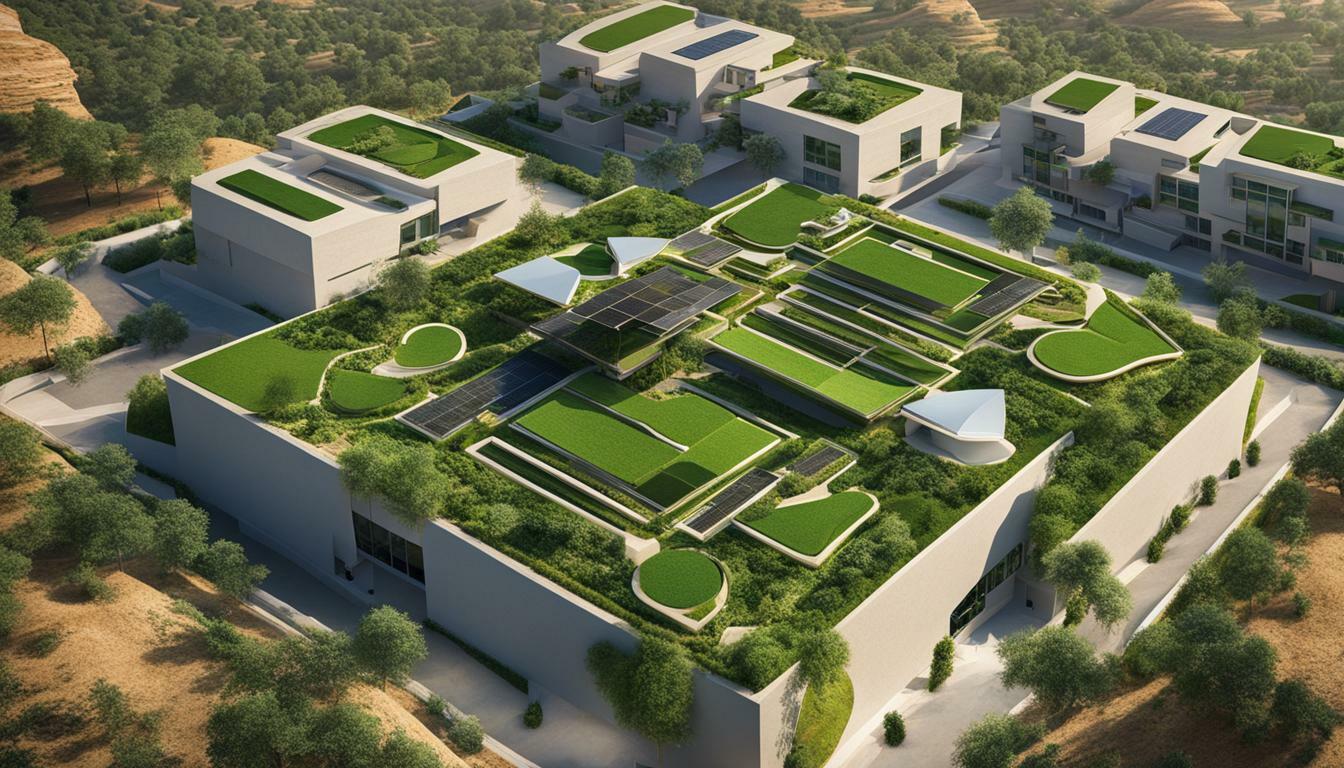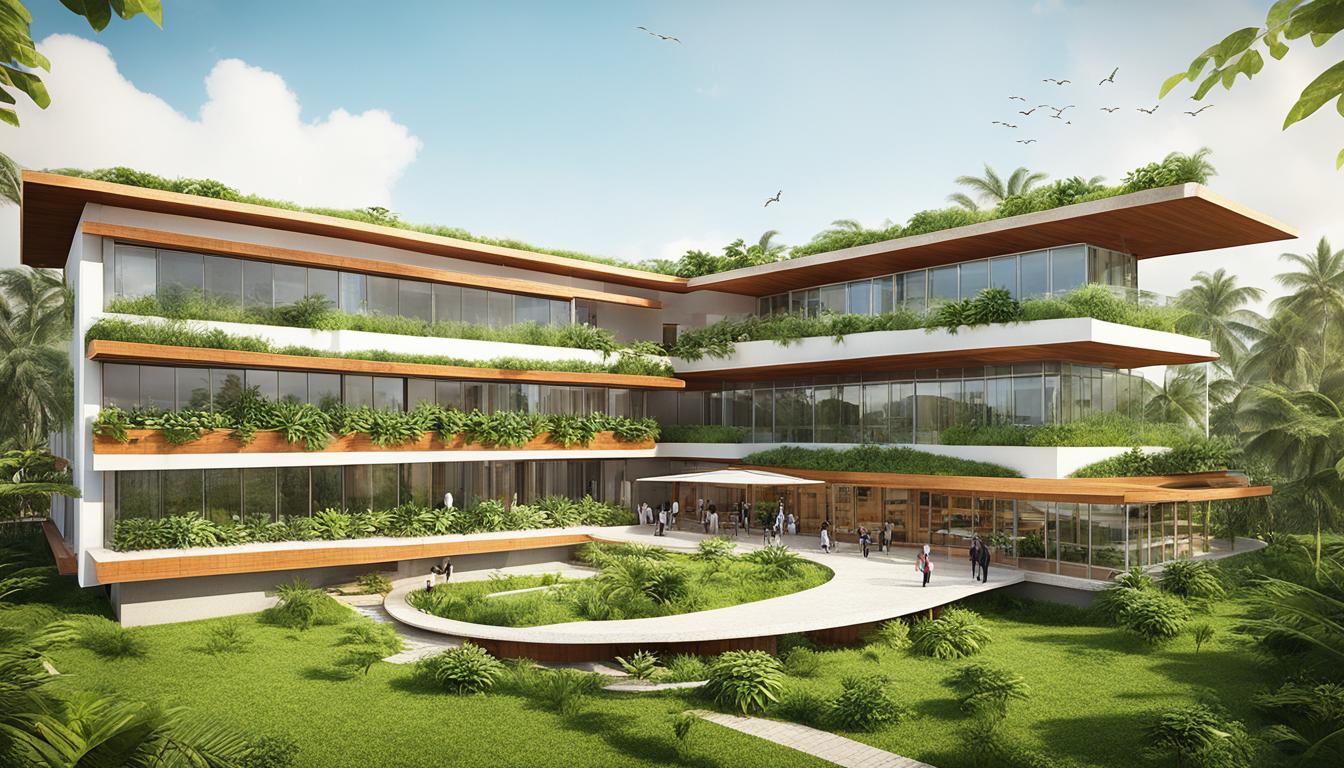China Green Building History
In recent years, China has become a global leader in sustainable construction practices and eco-friendly architecture. But the roots of this movement go back centuries, to traditional principles of environmental design that have been passed down from generation to generation. China’s commitment to sustainable urban development and green building initiatives has transformed its architectural landscape and positioned the country as a trailblazer in the field of environmental sustainability.
From ancient architecture that harmonized with natural surroundings to cutting-edge low-carbon building technologies, the history of green building in China is a testament to the power of innovation and forward-thinking. In this section, we will explore the evolution of green building in China, from its traditional principles to the modern sustainability practices that have shaped the country’s architectural landscape.
- China has a rich tradition of environmental design, rooted in principles that prioritize harmony with nature and sustainable urban development.
- The green building movement in China has gained traction in recent years, as awareness of environmental issues has grown globally.
- China has been at the forefront of developing green building standards and implementing low-carbon building technologies.
- Sustainable construction practices in China incorporate eco-friendly architecture into building designs, contributing to the country’s push for environmental sustainability.
- Energy efficiency is a crucial aspect of green building in China, with advancements in energy-efficient building design and technologies that have been implemented to reduce carbon emissions and promote sustainability.
Traditional Principles of Environmental Design in China
China has a rich history of environmental design, rooted in principles that prioritise harmony with nature and sustainable urban development. These traditional principles have influenced the sustainable development of cities in China and continue to be an important aspect of modern architecture.
One of the core principles of environmental design in China is the concept of “Feng Shui”, which emphasises the importance of placing buildings and structures in a way that complements the natural landscape. This involves a deep understanding of the environment and how different elements interact with each other, from the positioning of buildings to the flow of water and wind.
Another key principle is the use of natural materials, such as wood and bamboo, which are renewable and eco-friendly. Traditional buildings in China were often constructed using these materials, which are not only sustainable but also aesthetically pleasing. This approach to architecture has been incorporated into modern designs, with many buildings featuring sustainable materials and construction techniques.
The traditional principles of environmental design in China have also influenced the layout and design of cities, with a focus on creating sustainable communities that are integrated with nature. This includes the use of green spaces, such as parks and gardens, and the incorporation of water features, such as canals and lakes, to help regulate the city’s climate and improve air quality.
Overall, the traditional principles of environmental design in China have played an important role in shaping the country’s approach to sustainable urban development. These principles continue to be relevant today, as China seeks to create green, liveable cities that are in harmony with the environment.

The green building movement began to gain momentum in China as environmental issues gained greater recognition on a global scale. As the country began to focus on sustainable development, various initiatives were introduced to promote sustainable construction practices.
The Chinese government played a key role in promoting the green building movement, with the launch of the “Green Building Action Plan” in 2014. The plan set out ambitious targets for the construction of green buildings, with the aim of increasing the proportion of new green buildings to 50% by 2020.
One of the main green building initiatives in China is the China Green Building Label, which evaluates buildings based on their energy efficiency, environmental impact, and overall sustainability. The label is awarded to buildings that meet certain environmental standards, and has become an important benchmark for sustainable construction in China.

Another notable initiative is the establishment of the China Green Building Council (CGBC) in 2006, which is dedicated to promoting green building practices and technologies in China. The CGBC has played a key role in shaping the green building landscape in China, and has been instrumental in driving the adoption of low-carbon building technologies and sustainable construction practices.
The green building movement in China has also been supported by international organizations such as the United Nations Environment Programme (UNEP), which has partnered with the Chinese government to promote sustainable building practices.
Overall, the emergence of the green building movement in China has been a significant step forward in the country’s push for sustainable urban development. With the support of government policies and initiatives, as well as international partnerships, China is well-positioned to continue leading the way in promoting sustainable construction practices.
Evolution of Green Building Standards in China
China has made significant strides in developing green building standards and implementing low-carbon building technologies. The country’s commitment to sustainability has led to the formation of several green building rating systems, including the Leadership in Energy and Environmental Design (LEED) certification and the China Green Building Evaluation Label.
LEED, developed by the U.S. Green Building Council, sets the global standard for sustainable building design, construction, and operation. China adopted LEED in 2005, and since then, more than 1,000 building projects in China have received LEED certification.

In addition to LEED, China has also established its own green building rating system, the China Green Building Evaluation Label. The label evaluates buildings based on energy efficiency, water conservation, material selection, indoor environment quality, and operational management. Buildings that meet the criteria are awarded a one-star, two-star, or three-star rating.
China’s focus on green building has also spurred the development of low-carbon building technologies. These technologies aim to reduce the carbon footprint of buildings by using renewable energy sources, such as solar and wind power, and increasing energy efficiency through measures such as building insulation and efficient lighting systems.
The adoption of green building standards and low-carbon building technologies has had a significant impact on China’s construction industry. Green buildings are becoming increasingly common in China, and the demand for sustainable building materials and technologies is on the rise.
Sustainable Construction Practices in China
China has been at the forefront of sustainable construction practices, embracing eco-friendly architecture and green building standards. The country’s commitment to sustainability is reflected in its construction industry, which has adopted a variety of sustainable practices to reduce its ecological footprint.
One of the most popular sustainable construction practices in China is the use of renewable energy sources. China has invested heavily in solar and wind energy, becoming the largest producer of both in the world. This investment has translated into construction practices, with the integration of solar panels and wind turbines into building designs. These practices not only reduce the building’s reliance on non-renewable energy sources but also contribute to the country’s goal of reducing carbon emissions.
Another sustainable construction practice has been the reuse and recycling of building materials. This circular economy approach reduces waste and conserves resources, contributing to the country’s push for environmental sustainability. Additionally, many buildings in China incorporate green roofs and walls, which not only provide insulation but also help to filter air pollutants and reduce the urban heat island effect, creating a more comfortable and healthy indoor environment.
The construction industry in China has also embraced low-carbon building technologies, investing in high-efficiency heating and cooling systems, smart building management systems, and energy-efficient lighting. These technologies, when combined with sustainable construction practices, create energy-efficient buildings that reduce carbon emissions and increase energy savings.

“Sustainable construction practices, such as the use of renewable energy sources and the reuse of building materials, not only reduce the building’s carbon footprint but also contribute to the country’s goal of reducing carbon emissions.”
Sustainable construction practices in China are not limited to new construction projects. In fact, many existing buildings in China have undergone retrofits to incorporate sustainable features, such as green roofs and walls, solar panels, and energy-efficient lighting. This trend towards retrofitting existing buildings is an important part of China’s push towards sustainable urban development, as it reduces waste and maximizes the use of existing resources.
Overall, China’s embrace of sustainable construction practices and eco-friendly architecture has positioned the country as a leader in the field of sustainable urban development. Its commitment to reducing carbon emissions and creating a healthy and sustainable environment for its citizens is reflected in the construction industry’s adoption of various sustainable practices.
Energy-Efficient Buildings in China
China has made great strides in developing energy-efficient buildings that significantly reduce carbon emissions. Low-carbon building technologies have played a key role in this endeavour, with the adoption of green construction materials and advanced insulation techniques.
The push for energy-efficient buildings has also led to the development of innovative energy-saving systems, such as smart lighting controls, occupancy sensors, and automated energy management systems. These systems help reduce energy consumption and improve building efficiency, resulting in significant cost savings over time.
One notable example is the Shanghai Tower, which is one of the tallest buildings in the world and was designed to achieve a 21% reduction in energy consumption compared to conventional buildings. The tower uses a variety of energy-efficient features, such as a double-skin façade, a high-performance ventilation system, and a rainwater harvesting system that supplies non-potable water for irrigation and cooling.

The adoption of energy-efficient building design and technologies has not only reduced carbon emissions but also improved the quality of life for occupants. Buildings that incorporate natural ventilation, daylighting, and green spaces have been shown to enhance wellbeing and contribute to a healthier living environment.
As China continues to invest in sustainable urban development, the demand for energy-efficient buildings is expected to increase. The country’s commitment to low-carbon building technologies and green construction practices will undoubtedly pave the way for a more sustainable future.
The Future of Green Building in China
The future of China’s built environment is looking increasingly sustainable, with the government investing heavily in green building initiatives to promote sustainable urban development. In line with the country’s commitment to achieving carbon neutrality by 2060, the focus on eco-friendly architecture and sustainable construction practices is set to become even more prominent in the years ahead.
As China continues to rapidly urbanize, sustainable urban development has become a key area of focus. The government’s ‘New Urbanization Plan’ aims to create sustainable cities, with an emphasis on the integration of green spaces, renewable energy, and low-carbon transportation systems. This will require a coordinated effort between the public and private sectors, as well as collaboration with international partners.
The green building movement in China is also set to gain momentum, with the government introducing a number of initiatives to promote sustainable construction practices. These include the Green Building Evaluation Label, which assesses the sustainability of buildings and encourages the use of low-carbon building technologies. The government has also launched the ‘Nearly Zero Energy Building’ program, which aims to reduce energy consumption in buildings.
Looking ahead, the focus on energy-efficient buildings is likely to become more pronounced, with the government incentivizing the use of renewable energy technologies such as solar panels and geothermal heating systems. The development of smart buildings is also expected to gather pace, with the integration of sensors and other technologies optimizing energy usage and improving building performance.

Overall, the future of green building in China looks promising, with a commitment to sustainable urban development and green building initiatives driving the country towards a more environmentally conscious future.
The Future of Green Building in China
China’s commitment to sustainable urban development and green building initiatives is paving the way for an environmentally conscious future. The country’s long-standing tradition of environmental design, combined with modern sustainable practices, has made it a global leader in the field of green building.
Sustainable urban development
China recognizes the importance of sustainable urban development and has implemented various measures to reduce greenhouse gas emissions, improve air and water quality, and promote eco-friendly transportation. The government’s commitment to sustainable urban planning is reflected in the development of green building standards, policies, and certifications that encourage eco-friendly buildings and infrastructure.
Green building initiatives
The green building movement in China has gained significant momentum over the past decade with various initiatives aimed at promoting sustainable construction practices. China’s Green Building Evaluation Standard, launched in 2006, is one of the world’s most comprehensive green building rating systems, covering the entire lifecycle of a building from design to construction and operation. Additionally, the government has introduced financial incentives, tax breaks, and subsidies to encourage developers and builders to adopt green building practices.
Role in addressing climate change
Green building has an essential role to play in addressing climate change by reducing carbon emissions and promoting sustainability. China’s push towards sustainable urban development and green building initiatives can help the country achieve its goal of reaching carbon neutrality by 2060. By promoting energy-efficient buildings, reducing waste, and promoting eco-friendly transportation, China can pave the way for a more sustainable future.
Conclusion
China’s history of green building has seen a remarkable transformation from traditional principles of environmental design to modern, eco-friendly practices. Its commitment to sustainable urban development and green building initiatives positions the country as a global leader in the field of sustainability. Through its various initiatives, China is creating a better future for its citizens and the planet.
China Green Building History
FAQ
What is the history of green building in China?
The history of green building in China spans from its traditional principles of environmental design to the modern adoption of sustainable construction practices. It has evolved over time to prioritize eco-friendly architecture and contribute to the green building movement in the country.
What are the traditional principles of environmental design in China?
China has a rich tradition of environmental design that emphasizes harmony with nature and sustainable urban development. These principles have influenced the way cities are planned and built, with a focus on creating a balance between human settlements and the natural environment.
How did the green building movement emerge in China?
The green building movement in China emerged as global awareness of environmental issues grew. Various initiatives were introduced to promote sustainable construction practices and raise awareness about the importance of eco-friendly architecture in reducing carbon emissions and preserving natural resources.
What are the green building standards in China?
China has been at the forefront of developing green building standards and implementing low-carbon building technologies. These standards aim to reduce energy consumption, promote resource efficiency, and create healthier living and working environments through sustainable building practices.
What are the sustainable construction practices adopted in China?
China has embraced various sustainable construction practices, such as using renewable materials, implementing energy-efficient technologies, and incorporating green design principles. These practices aim to minimize the environmental impact of buildings and promote long-term sustainability.
How are energy-efficient buildings promoted in China?
Energy efficiency is a key focus of green building in China. The country has made significant advancements in energy-efficient building design and technologies, including the use of low-carbon materials, efficient insulation, and innovative HVAC systems, to reduce carbon emissions and enhance energy performance.
What does the future hold for green building in China?
China is committed to sustainable urban development and green building initiatives, positioning itself as a global leader in promoting environmental consciousness. The future of green building in China will likely see further advancements in sustainable construction practices and the creation of greener, more sustainable cities.
Conclusion
The history of green building in China demonstrates a remarkable transformation from traditional principles of environmental design to the adoption of modern, sustainable construction practices. China’s commitment to eco-friendly architecture, green building standards, and low-carbon technologies puts it in a leading position in the global pursuit of sustainable urban development.








